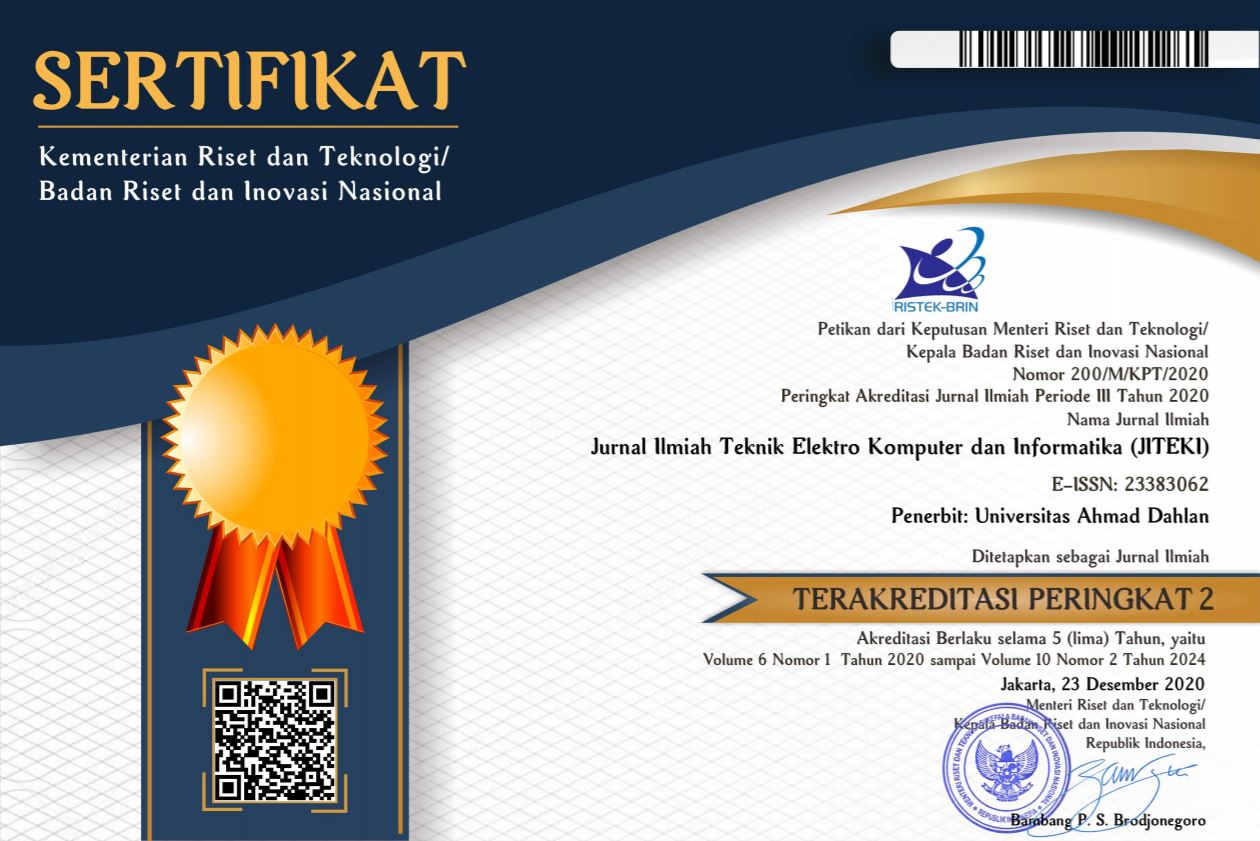A Hybrid CNN-SVR for Airfoil Aerodynamic Coefficient Prediction
Abstract
Keywords
Full Text:
PDFReferences
H. Chen, L. He, W. Qian, and S. Wang, “Multiple aerodynamic coefficient prediction of airfoils using a convolutional neural network,” Symmetry (Basel), vol. 12, no. 4, Apr. 2020, doi: 10.3390/SYM12040544.
K. Balla, R. Sevilla, O. Hassan, and K. Morgan, “An application of neural networks to the prediction of aerodynamic coefficients of aerofoils and wings,” Appl Math Model, vol. 96, pp. 456–479, Aug. 2021, doi: 10.1016/j.apm.2021.03.019.
K. K. Chaitanyaa, C. R. Patil, B. Pal, and D. Dandotiya, “Aerodynamic Analysis and Optimization of Airfoils Using Vortex Lattice Method,” in IOP Conference Series: Materials Science and Engineering, IOP Publishing Ltd, Jan. 2021. doi: 10.1088/1757-899X/1013/1/012023.
Y. Wang, K. Shimada, and A. Barati Farimani, “Airfoil GAN: encoding and synthesizing airfoils for aerodynamic shape optimization,” J Comput Des Eng, vol. 10, no. 4, pp. 1350–1362, Aug. 2023, doi: 10.1093/jcde/qwad046.
D. A. Masters, N. J. Taylor, T. C. S. Rendall, C. B. Allen, and D. J. Poole, “A Geometric Comparison of Aerofoil Shape Parameterisation Methods,” 2017.
J. D. Hoyos, C. Echavarría, J. P. Alvarado, G. Suárez, J. A. Niño, and J. I. García, “Two-Way Coupled Aero-Structural Optimization of Stable Flying Wings,” Aerospace, vol. 10, no. 4, Apr. 2023, doi: 10.3390/aerospace10040346.
J. Yi and F. Deng, “Cooperation of Thin-Airfoil Theory and Deep Learning for a Compact Airfoil Shape Parameterization,” Aerospace, vol. 10, no. 7, Jul. 2023, doi: 10.3390/aerospace10070650.
M. H. Masud, Naim-Ul-Hasan, A. M. E. Arefin, and M. U. H. Joardder, “Design modification of airfoil by integrating sinusoidal leading edge and dimpled surface,” in AIP Conference Proceedings, American Institute of Physics Inc., Jun. 2017. doi: 10.1063/1.4984677.
H. Hares and G. Mebarki, “Influence of Wing Shape on Airfoil Performance: a Comparative Study,” WSEAS Transactions on Fluid Mechanics, vol. 18, pp. 49–57, 2023, doi: 10.37394/232013.2023.18.5.
J. Winslow, H. Otsuka, B. Govindarajan, and I. Chopra, “Basic understanding of airfoil characteristics at low Reynolds numbers (104–105),” J Aircr, vol. 55, no. 3, pp. 1050–1061, 2018, doi: 10.2514/1.C034415.
O. A. Zargar et al., “The effects of surface modification on aerodynamic characteristics of airfoil DU 06 W 200 at low Reynolds numbers,” International Journal of Thermofluids, vol. 16, Nov. 2022, doi: 10.1016/j.ijft.2022.100208.
F. L. Rashid, H. S. Abd, and E. Q. Hussein, “Numerical study of the air flow over modified NACA 2412 airfoil using CFD,” in AIP Conference Proceedings, American Institute of Physics Inc., Dec. 2022. doi: 10.1063/5.0092303.
J. Hoyos, J. H. Jímenez, C. Echavarría, and J. P. Alvarado, “Airfoil Shape Optimization: Comparative Study of Meta-heuristic Algorithms, Airfoil Parameterization Methods and Reynolds Number Impact,” IOP Conf Ser Mater Sci Eng, vol. 1154, no. 1, p. 012016, Jun. 2021, doi: 10.1088/1757-899x/1154/1/012016.
Y. Sowmyashree et al., “Study on effect of semi-circular dimple on aerodynamic characteristics of NACA 2412 airfoil,” in AIP Conference Proceedings, American Institute of Physics Inc., Jan. 2020. doi: 10.1063/1.5141572.
M. T. Islam, A. M. E. Arefin, M. H. Masud, and M. Mourshed, “The effect of Reynolds number on the performance of a modified NACA 2412 airfoil,” in AIP Conference Proceedings, American Institute of Physics Inc., Jul. 2018. doi: 10.1063/1.5044325.
R. BALA?A, C. C. ANDREI, A. G. ANDREI, and A. SEMENESCU, “THE IMPACT OF DIFFERENT OUTWARD AND INWARD PROTRUSION POSITIONS ON THE NACA 1410 AIRFOIL SECTION AT VARIOUS ANGLES OF ATTACK,” Mechanical Testing and Diagnosis, vol. 11, no. 2, pp. 10–17, Jul. 2021, doi: 10.35219/mtd.2021.2.02.
C. Lozano, “Surrogate modelling for aerodynamic coefficients prediction in aeronautical configurations,” 2019, doi: 10.13009/EUCASS2019-870.
J. Tao and G. Sun, “Application of deep learning based multi-fidelity surrogate model to robust aerodynamic design optimization,” Aerosp Sci Technol, vol. 92, pp. 722–737, Sep. 2019, doi: 10.1016/j.ast.2019.07.002.
E. Andrés-Pérez, “Data mining and machine learning techniques for aerodynamic databases: Introduction, methodology and potential benefits,” Energies (Basel), vol. 13, no. 21, Nov. 2020, doi: 10.3390/en13215807.
B. N. Hanna, N. T. Dinh, R. W. Youngblood, and I. A. Bolotnov, “Machine-learning based error prediction approach for coarse-grid Computational Fluid Dynamics (CG-CFD),” Progress in Nuclear Energy, vol. 118, Jan. 2020, doi: 10.1016/j.pnucene.2019.103140.
W. Peng, Y. Zhang, E. Laurendeau, and M. C. Desmarais, “Learning aerodynamics with neural network,” Sci Rep, vol. 12, no. 1, Dec. 2022, doi: 10.1038/s41598-022-10737-4.
Z. H. Han, J. Chen, K. S. Zhang, Z. M. Xu, Z. Zhu, and W. P. Song, “Aerodynamic shape optimization of natural-laminar-flow wing using surrogate-based approach,” AIAA Journal, vol. 56, no. 7, pp. 2579–2593, 2018, doi: 10.2514/1.J056661.
P. Dai et al., “SparseTrain: Exploiting dataflow sparsity for efficient convolutional neural networks training,” in Proceedings - Design Automation Conference, Institute of Electrical and Electronics Engineers Inc., Jul. 2020. doi: 10.1109/DAC18072.2020.9218710.
H. Moin, H. Z. I. Khan, S. Mobeen, and J. Riaz, “Airfoil’s Aerodynamic Coefficients Prediction using Artificial Neural Network,” Sep. 2021, doi: 10.1109/IBCAST54850.2022.9990112.
P. Gupta and R. K. Singh, “Analysis of Generative Adversarial Networks for Data Driven Inverse Airfoil Design Analysis of Generative Adversarial Networks for Data Driven Inverse Airfoil Design,” 2021.
J. Li, X. Du, and J. R. R. A. Martins, “Machine learning in aerodynamic shape optimization,” Progress in Aerospace Sciences, vol. 134. Elsevier Ltd, Oct. 01, 2022. doi: 10.1016/j.paerosci.2022.100849.
Z. Ti, X. W. Deng, and H. Yang, “Wake modeling of wind turbines using machine learning,” Appl Energy, vol. 257, Jan. 2020, doi: 10.1016/j.apenergy.2019.114025.
I. L. Jernelv, D. R. Hjelme, Y. Matsuura, and A. Aksnes, “Convolutional neural networks for classification and regression analysis of one-dimensional spectral data,” May 2020, [Online]. Available: http://arxiv.org/abs/2005.07530.
Y. Lecun, L. Eon Bottou, Y. Bengio, and P. H. Abstract|, “Gradient-Based Learning Applied to Document Recognition.”
Y. Zhang, W.-J. Sung, and D. Mavris, “Application of Convolutional Neural Network to Predict Airfoil Lift Coefficient,” Dec. 2017, [Online]. Available: http://arxiv.org/abs/1712.10082.
X. Hui, J. Bai, H. Wang, and Y. Zhang, “Fast pressure distribution prediction of airfoils using deep learning,” Aerosp Sci Technol, vol. 105, Oct. 2020, doi: 10.1016/j.ast.2020.105949.
Z. Yuan, Y. Wang, Y. Qiu, J. Bai, and G. Chen, “Aerodynamic Coefficient Prediction of Airfoils with Convolutional Neural Network,” in Lecture Notes in Electrical Engineering, Springer Verlag, 2019, pp. 34–46. doi: 10.1007/978-981-13-3305-7_3.
A. Khan, A. Sohail, U. Zahoora, and A. S. Qureshi, “A survey of the recent architectures of deep convolutional neural networks,” Artif Intell Rev, vol. 53, no. 8, pp. 5455–5516, Dec. 2020, doi: 10.1007/s10462-020-09825-6.
M. M. Najafabadi, F. Villanustre, T. M. Khoshgoftaar, N. Seliya, R. Wald, and E. Muharemagic, “Deep learning applications and challenges in big data analytics,” J Big Data, vol. 2, no. 1, Dec. 2015, doi: 10.1186/s40537-014-0007-7.
G. Zhang, Z. Dai, and X. Dai, “A Novel Hybrid CNN-SVR for CRISPR/Cas9 Guide RNA Activity Prediction,” Front Genet, vol. 10, Jan. 2020, doi: 10.3389/fgene.2019.01303.
S. Rastegar, H. Gholam Hosseini, and A. Lowe, “Hybrid CNN-SVR Blood Pressure Estimation Model Using ECG and PPG Signals,” Sensors, vol. 23, no. 3, Feb. 2023, doi: 10.3390/s23031259.
S. Ghimire, B. Bhandari, D. Casillas-Pérez, R. C. Deo, and S. Salcedo-Sanz, “Hybrid deep CNN-SVR algorithm for solar radiation prediction problems in Queensland, Australia,” Eng Appl Artif Intell, vol. 112, Jun. 2022, doi: 10.1016/j.engappai.2022.104860.
M. O. Khairandish, M. Sharma, V. Jain, J. M. Chatterjee, and N. Z. Jhanjhi, “A Hybrid CNN-SVM Threshold Segmentation Approach for Tumor Detection and Classification of MRI Brain Images,” IRBM, vol. 43, no. 4, pp. 290–299, Aug. 2022, doi: 10.1016/j.irbm.2021.06.003.
S. Ahlawat and A. Choudhary, “Hybrid CNN-SVM Classifier for Handwritten Digit Recognition,” in Procedia Computer Science, Elsevier B.V., 2020, pp. 2554–2560. doi: 10.1016/j.procs.2020.03.309.
F. Rahman, S. Wasim, and U. Huda, “Numerical Analysis of Modified NACA 4412 Airfoil for Implementation of Low Reynolds Numbers VAWTs,” 2022. [Online]. Available: https://www.researchgate.net/publication/380099778.
A. Kulshreshtha, S. K. Gupta, and P. Singhal, “FEM/CFD analysis of wings at different angle of attack,” in Materials Today: Proceedings, Elsevier Ltd, 2019, pp. 1638–1643. doi: 10.1016/j.matpr.2020.02.342.
Mohammad Erfan Khodabakhshi and Masoud Aryanpour, “Numerical Solution of Inviscid and Viscous Flow Across NACA0010 Airfoil with different Angles of Attack,” Int J Sci Res Sci Eng Technol, pp. 268–279, Aug. 2023, doi: 10.32628/ijsrset23103211.
DOI: http://dx.doi.org/10.26555/jiteki.v10i2.28890
Refbacks
- There are currently no refbacks.
Copyright (c) 2024 Sunarno Sunarno, Aniati Murni Arymurthy

This work is licensed under a Creative Commons Attribution-ShareAlike 4.0 International License.
| About the Journal | Journal Policies | Author | Information |
Organized by Electrical Engineering Department - Universitas Ahmad Dahlan
Published by Universitas Ahmad Dahlan
Website: http://journal.uad.ac.id/index.php/jiteki
Email 1: jiteki@ee.uad.ac.id



